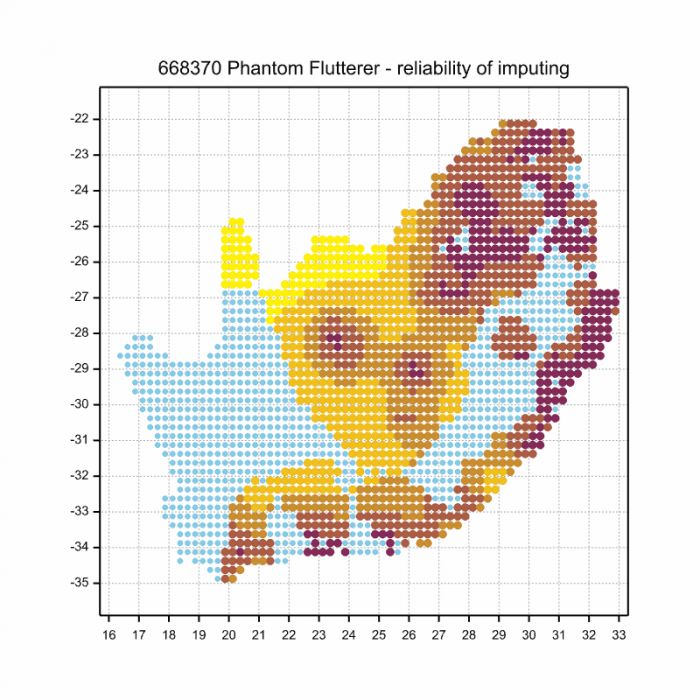View the above photo record (by Phillip Nieuwoudt) in OdonataMAP here.
Find the Phantom Flutterer in the FBIS database (Freshwater Biodiversity Information System) here.
Family Libellulidae
Rhyothemis semihyalina – PHANTOM FLUTTERER
(Desjardins, 1832)
Identification
Small to medium sized
Length up to 36mm; Wingspan attains 70mm.
This is a highly distinctive and recognisable species. It is unlikely to be confused with another dragonfly. The broad, metallic purple panel in each hindwing is distinctive.
The sexes are alike.
Click here for more details on identification of the Phantom Flutterer.

Near Hluhluwe, KwaZulu-Natal
Photo by Ryan Tippett
Habitat
Inhabits the still-water habitats of marshes, floodplains, pans and slow-moving rivers. Prefers sites that are rich in emergent reeds, grasses, sedge and water lilies. Utilises both permanent and ephemeral waterbodies.

Photo by Ryan Tippett
Behaviour
Usually seen perched on a plant stem, at a sunny site over the water. Most often sits with the abdomen pointed downwards at a 45 degree angle. It has a fluttering butterfly-like flight. Non-breeding individuals can sometimes be seen in the tree tops of surrounding woodlands. Sometimes gregarious as they hover above clouds of tiny swarming insects, in woodland clearings or over the water.
Status and Conservation
Generally common where it occurs and is listed as of Least Concern in the IUCN Red List of Threatened Species. Fairly resistant towards habitat degradation and frequently makes use of suitable man-made habitats such as ornamental ponds and farm dams. It is showing signs of increasing in abundance in the Eastern and Western Cape.
Distribution
Rhyothemis semihyalina is widely distributed throughout Sub-Saharan Africa, including West, Central, East and Southern Africa. It also occurs in parts of the Middle East, as well as Madagascar and many of the Indian Ocean islands. In South Africa is occurs mostly in the hot savanna regions of the Northern and NE provinces, and along the eastern coastal strip.
Below is a map showing the distribution of records for Phantom Flutterer in the OdonataMAP database as at February 2020.

The next map below is an imputed map, produced by an interpolation algorithm, which attempts to generate a full distribution map from the partial information in the map above. This map will be improved by the submission of records to the OdonataMAP section of the Virtual Museum.


Ultimately, we will produce a series of maps for all the odonata species in the region. The current algorithm is a new algorithm. The objective is mainly to produce “smoothed” maps that could go into a field guide for odonata. This basic version of the algorithm (as mapped above) does not make use of “explanatory variables” (e.g. altitude, terrain roughness, presence of freshwater — we will be producing maps that take these variables into account soon). Currently, it only makes use of the OdonataMAP records for the species being mapped, as well as all the other records of all other species. The basic maps are “optimistic” and will generally show ranges to be larger than what they probably are.
These maps use the data in the OdonataMAP section of the Virtual Museum, and also the database assembled by the previous JRS funded project, which was led by Professor Michael Samways and Dr KD Dijkstra.
Further Resources
Virtual Museum (OdonataMAP > Search VM > By Scientific or Common Name)
More common names: Fladdergesie (Afrikaans)
Type Locality: Mauritius, no locality data available.
Recommended citation format: Loftie Eaton. M; Hofmeyr S; Tippett RM; Underhill L. Phantom Flutterer Rhyothemis semihyalina. Biodiversity and Development Institute. Available online at http://thebdi.org/2020/05/11/phantom-flutterer-rhyothemis-semihyalina/

